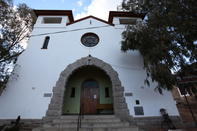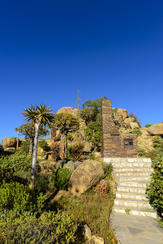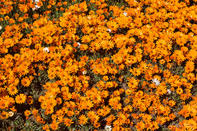Stay Awhile
At first glance, there’s not much to recommend Springbok. It is a hot and dusty place, surrounded by granite outcrops that are covered with dark vegetation. There are a couple of attractive sandstone churches and a pretty little rock garden built on a boulder in the centre of the town.

But that’s about it. Nevertheless, Springbok has a subtle charm and a laid-back atmosphere, and there are several very worthwhile attractions nearby which make it a good place to spend a couple of days. It also offers easy access to a number of excellent flower-spotting sites, a wide range of accommodation options and an excellent tourist info centre with well-informed staff.
So, all in all, it should rank quite high up on your Namaqualand itinerary. In terms of food, there isn’t much fine dining to be had, but most of the hotels and guest houses have a restaurant attached. You will find plenty of fast-food places, though, including a very popular KFC, a Wimpy and a couple of dodgy hamburger joints on the main road.
There are also several independent restaurants. The architecture of Springbok tends towards the utilitarian; low buildings with corrugated-tin roofs that beat back the summer heat. The main church is very attractive, however, and the Edwardian-style Springbok Hotel and art-deco façade of the Masonic Hotel are also notable.
Extensive Gemstone Collection

While you’re in town, check out the local museum housed in the old Jewish synagogue, located next to the Springbok Hotel. This was the centre of Namaqualand’s once-influential Jewish community, most of whom came into the area after fleeing the Pogroms in central Russia.
Initially, they earned their living as smouses – travelling salesman who sold pots, pans, cloth and other useful merchandise from the back of their ox-wagons. A number of these itinerant peddlers eventually settled in Springbok to service the mines in the area. Now, however, the last Jewish families have left for greener pastures in the bigger cities of South Africa and abroad.
The museum contains an appealing clutter of artefacts, including old books, typewriters, documents and dresses, while fading info boards take you through the town’s history. Next door, the old Jewish festival hall contains a newly established community-run art gallery and herbal tea shop, where you can buy paintings and embroidery made by local artists and craftworkers – an initiative that is well worth supporting. Another good place to visit is the Springbok Lodge and Café.
This unlikely looking establishment stocks an excellent selection of books on Namaqualand and Namibia, some of which are out of print and hard to find. They also have an extensive gemstone collection and a fun semi-precious scratch patch for the kids. The knowledgeable staff at the lodge can arrange trips to the old Blue Mine, the first commercial copper mining site in the region, and other interesting sites in the area. The burgers from the attached restaurant are popular too.
Messelpad and Wildeperdhoek Pass

Drive about 15 km south from Springbok on the N7 and then take the turn-off marked for Hondeklip Bay and Soebatsfontein. This is the old Messelpad (Mason’s Road) which was once the main thoroughfare for the copper riders who transported the ore from the Springbok mines to the harbour at Hondeklip.
Today, this neglected gravel road cuts a tawny-coloured strip through the majestic mountains and the extensive dry-stone retaining walls, which gave the road its name, can still be seen. It’s a breathtaking drive, but you probably won’t see many daisies, apart from a particularly impressive display on a farm about 12 km from the highway.
The succulent displays, however, are excellent. After about 35 km from Springbok, you’ll see a small turn-off that leads back to the N7. This will return you to Springbok in a round trip of about 100 km. However, the best part of the Messelpad is still to come, so continue driving until the road starts winding down a steep valley covered in succulents and aloes.
This breathtaking stretch of gravel track then leads along the banks of the muddy Buffels River, which is lined with deep green trees, before rising up again and wending its way through the mountains once more. On this part of the road, you’ll see a sign for the ‘historic prison’ that indicates the location of the old prisoners’ compound, where the convict labour that built the pass was housed. Park your car in the demarcated area if you want to walk down to the prison and wander about the ruins.
The road then continues as the Wildeperdhoek Pass (pass of the wild horses) until it reaches a large cleft in the mountains. From here, there is an amazing view out over the Namaqua National Park below. Keep following the road as it clings to the sheer edge of the cliff face, with a precipitous drop-off to your left. The track now swoops along through the mountainous contours and descends to reach the shrub-covered plains.
From here (about 55 km from Springbok), you can either follow signs to the National Park reception area (which eventually connects to the N7 at Kamieskroon), or you can follow signs for Koningaas/Soebatsfontein and then turn north towards Kommagas to return to Springbok via Spektakel Pass. Either way, it’s a worthwhile round trip of about 160 km.
Hester Malan Flower Reserve

Drive through Springbok in the winter and you'll have no idea what an awesome display of colour the plants of this Namaqualand town lays on in the springtime. The Hester Malan Flower Reserve inside the Goegap Nature Reserve is an inspired place after the rains. Be sure to explore the nature reserve and check out the rare succulents and quiver trees while you're there.
For those who have the time to venture even further, flower cornucopia can be found up the N7 on a series of drives around the towns of Springbok and Port Nolloth. Namaqualand daisies stretch to the horizon in an ocean of colour. For botanists, this is where they feel they’ve died and gone to heaven.
By David Fleminger